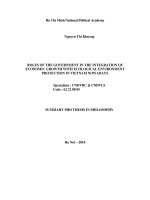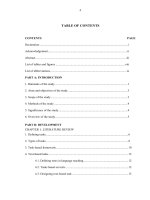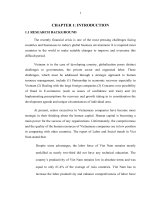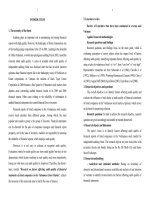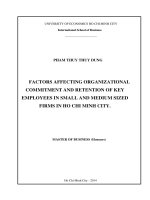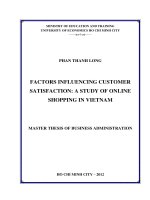Summary PhD thesis: The internal factors affecting the accounting information transparency of non-business entities in Vietnam
Bạn đang xem bản rút gọn của tài liệu. Xem và tải ngay bản đầy đủ của tài liệu tại đây (382.66 KB, 28 trang )
MINISTRY OF EDUCATION AND TRAINING
UNIVERSITY OF ECONOMIC HCMC
DAU THI KIM THOA
THE INTERNAL FACTORS AFFECTING THE
ACCOUNTING INFORMATION
TRANSPARENCY OF NON-BUSINESS
ENTITIES IN VIETNAM
Major: Accounting
Code: 9340301
PhD THESIS - SUMMARY
Supervisor: Associate
Prof., Dr. VO VAN NHI
HO CHI MINH CITY - 2019
Is conducted at:
University of Economic Ho Chi Minh city
Supervisor: Associate
Prof., Dr. VO VAN NHI
Reviewer 1: ................................................................................
Reviewer 2: ................................................................................
Reviewer 3: ................................................................................
The thesis will be presented to the University Dissertation
Board at: ....................................................................................
....................................................................................................
At
day
month
year
The thesis can be found at the library: …………….……… .
1
INTRODUCTION
1. Necessary of the topic
The accounting information transparency usefulness: it plays an
important role in determining the decision-making effectiveness of
their information users. Moreover, it also determines the national
economic growth through direct or indirect impacts in the public
sector. Specifically:
• Supporting the Governmental agencies, citizen, donors,... to
assess the effectiveness and efficiency of using the state budget
of the non-business entities to be able to establish the fund
allocation policies suitably.
• Creating conditions for citizen to participate in monitoring the
activities of public agencies which lead to an increase in
accountability and providing more conscious information about
the non-business entities’ performance and tasks. As the result, it
improves effectiveness of the provided public services.
• Playing a primary role in preventing corruption, increasing
people's believe, and activating more accountability.
• Attracting domestic and international investments, aids and funds
in the international economic integration trend.
The context of Vietnam:
• Vietnam is still one of the highest corruption countries, which has
led to control and monitor difficultly the effectiveness and
efficiency of the state budget using of Government. As a result,
believe of the citizen, donors, investors... significantly decreased.
• Vietnam's economy is developing in the industrialization
direction, which needs extremely investments, aid and funding to
2
improve economy and reduce economic crisis, poverty and
corruption.
Researches in Vietnam
about the accounting information
transparency: On over the world, the issue has been considerable
interested from researchers and practitioners during in the past
decades. In Vietnam, the number of studies about the topic are quite
limited and there is a large gap in the research in the general public
sector and particularly the non-business entities in Vietnam. Beside,
these units have a high special operation, which are compared to the
private sector as well as the public sector of the other countries. Their
accounting information users are becoming diversification and
requiring more the accounting information transparent.
The above reasons explain for necessary of identifying the factors
affecting the accounting information transparent which support the
related authority agencies in establishing policies towards the nonbusiness entities’ transparency inVietnam.
2. The Thesis Objectives and Questions
The general objective: Determining the internal factors affecting
the accounting information transparent of the Vietnamese nonbusiness entities.
The specific objectives:
(1) Determining the internal factors affecting the accounting
information transparent of the Vietnamese non-business entities.
(2) Determining measurement scales the accounting information
transparent of the Vietnamese non-business entities.
(3) Evaluating effective level of the factors to the accounting
information transparent.
The research questions:
3
(1) What internal factors influence the accounting information
transparent of the Vietnamese non-business entities?
(2) What scale measures the accounting information transparent?
(3) How is the accounting information transparent influenced by the
identified internal factors?
3. Subject and Scope
Research subject: the accounting information transparent and the
internal factors affecting the accounting information transparent of
the Vietnamese non-business entities.
Survey subject: the top managers, accounting manager, accountant,
and union chairman of the organizations.
Analytical unit: it is the unit, specifically, Vietnamese non-business
entities.
Research scope: The thesis focuses on two issues: (1) the
information transparent which are presented on the accounting
statements (the financial statements and the budget statements); and
(2) Identifying internal factors affecting the accounting information
transparent of the Vietnamese non-business entities.
4. Research method
The mixed method is applied in this thesis, which includes the
qualitative research and quantitative research, specially:
Qualitative research: to achieve the following targets:
- Identify the accounting information transparent concept and the
research model via literature review and related basic theories.
- Adjust the proposed research model as well as measurement scales
of the related research concepts through interview experts.
Quantitative research: evaluate the measurement scales and
examine the structural model.
4
5. Thesis contributions
- Identifying the accounting information transparent concept of the
Vietnamese non-business entities.
- Supplementing the accounting information transparent scale of the
non-business entities in Vietnam.
- Determining the internal factors affecting directly and indirectly
on the accounting information transparency of the non-business
entities in Vietnam as well as their impact levels.
- Providing useful implications towards the accounting information
transparency of the Vietnamese non-business entities to meet the
needs of related external information users and enhance
international integration.
6. Thesis structure
The thesis includes five chapters: Chapter 1- literature review;
Chapter
2-
theoretical
frameworks;
Chapter
3-
research
methodology; Chapter 4- research results and discussion; Chapter 5Conclusion and several implications.
CHAPTER 1: LITERATURE REVIEW
1.1. Introduction
This chapter presents an overview of the accounting information
transparency and the its factors affecting which basic on previous
studies in the world and in Vietnam. After that the research gap as
well as the research direction have been derived from the fist step.
1.2. The accounting information transparency and the factors
influencing on the accounting information transparency
To synthesize foreign studies, the author has found prestigious
dissertations and articles. Data sources search domestic studies are
libraries of reputed domestic universities as well as journals.
5
1.2.1.
The accounting information transparency
1.2.1.1. The foreign studies about the accounting information
transparency
The accounting information transparency is an abstract concept
which is defined by many different perspectives and there is still no
a unified concept in the world. In general, the previous studies
identified the concept in 03 directions: (1) information disclosure;
(2) information quality; and (3) accountability. The research
tendency of these approaches has changed according to the
international economic development in the past several decades. In
the early period, 1970s, researchers focused more attention on the
information disclosure issues. In the 21st century, the research
direction moved on the information quality because the global
financial crisis in 2008 helped to realize that the information
disclosure is still not enough to ensure its transparency.
Transparency is that financial reports have to provide qualitative
information. In addition, accountability always played an important
role in the public sector, so it has been concerned very early and
continued to current. In recent years, the trend of the accounting
information transparent are applying e-government, or disclosing
information on Internet, Websites.
1.2.1.2. The domestic researches about accounting information
transparency
In Vietnam, this research tendency only started in 2008, which had
derived from the world financial crisis and the domestic economy
shifted to a market economy. In the private sector, this research
direction only has been focused on the listed companies on the stock
market. The primary study tendency is accounting information
6
quality and its measurement scale has been inherited from abroad
researches. Meanwhile, this problem in the public sector just has
been concerned in recent years with the major direction also has the
information quality.
1.2.2.
Factors affecting the accounting information quality
1.2.2.1. The foreign studies relate to the accounting information
transparency
The most of studies often combine two contents which determine
concept and the factors affecting the accounting information
transparency. Therefore, the identified factors are influenced on the
transparency
follow
three
dimensions,
namely
information
disclosure, information quality and accountability. The identified
factors in previous studies are quite diverse. Recent studies have
focused on factors affecting accountability associated with IT
development. However, there are no official theories or models have
been applied to explain the factors affecting the transparency so far.
1.2.2.2. The domestic studies relate to accounting information
transparency
The majority of researches in the private sector focus on determining
the factors affecting the accounting information transparency of the
listed companies. While this research direction is still large limited
in the public sector. Only a few studies identify factors affecting the
accounting information quality while many other studies also aim at
information transparency but they follow different research
directions, such as improving public financial system, the accounting
and budget accounting, the efficiency of distribution and using
public resources, establishing public accounting standards... A
number of solutions and implications improve the accounting
7
transparency in the Vietnamese public sector were proposed which
come from the research results.
1.3. Some assessments about previous studies
1.3.1.
Assessments about the foreign researches
The information transparency is extremely concerned by researchers
on over the world in many decades. In the beginning period, several
studies were done in developed economic countries but it has spread
to developing economic countries in the recent years.
Research subjects of the accounting information transparency in the
public sector which include general government to local
government. However, they concentrated greater at the lowest level
organizations because these units use directly state budget to provide
public services to society.
The research direction on the accounting information transparency
of both sections also focused on defining its concept and scale and
identifying factors affecting as well as solutions toward
transparency. Research trends in each issue of transparency have
changed in accordance to the world economic development.
1.3.2.
Assessments about the Vietnamese researches
The accounting information transparency in Vietnam is mentioned
much later than in the world, only started from 2008. It has been
studied more in the private sector than in the public sector.
The research direction has focused mainly on defining concept,
scale, factors affecting and proposing some suggests to improve the
accounting information transparency. The information quality is
researched the most in three approaches.
8
The number of high quality studies directly relate to determination
factors affecting the accounting information transparency in the
Vietnamese public sector still extremely limit.
At the present time, there are not any research which study the role
of applying e-government, or disclosing information on the Internet
in according to the current research trend on over the world.
1.4. Research gap and new research issues of the thesis
A number of major gaps of study about the accounting information
transparency in the public sector in the world and in Vietnam
nowadays are: (1) the amount of transparency studies which were
conducted in developing and underdeveloped economic countries,
such as Vietnam still extremely limited; (2) studying transparency of
public entities which use the state budget directly to provide
important public services should be focused; (3) The accounting
information transparency concept and measurement scale have not
been united; (4) the internal factors affecting the accounting
information
transparency
have
not
yet
been
sufficiently
implemented. There has not been any study to comprehensively
identify and test the internal factors affecting the accounting
information transparency of the non-business entities in Vietnam.
CHAPPTER 2: THEORICIAL FRAMEWORKS
2.1. Introduction
This chapter includes an overview of the accounting information
transparency, the Vietnamese non-business entities characteristics,
background theories and internal factors affecting the accounting
information transparency.
2.2. Overview of the accounting information transparency in the
public sector
9
2.2.1. The accounting information concept
In public sector, financial information is an essential part to predict
future activities, generated resources from future activities and possible
risks or uncertainties. These things serve to synthesize, evaluate and
control allocation, management, effectiveness and efficient of delegated
resources using. Financial information is also useful for assessing
accountability of public entities.
2.2.2. The accounting information transparency of the public
sector
The accounting information transparency is an abstract concept, it is
defined through many different perspectives and there is still no a
unified concept in the world. In general, the previous studies
identified the concept in 03 directions: (1) information disclosure;
(2) information quality; and (3) accountability. In particular,
information disclosure and information quality have a significantly
positive impact on the accounting information transparency while
the information transparency and accountability have a reciprocal
relationship together. The information transparency will reduce
corruption in the public sector noticeably, and enhance the quality of
public services - these are two issues that are the top concerns of any
country to develop national economy.
Information quality characteristics according to the research of Lee
et al. (2002) have covered all characteristics of the accounting
information quality which were shown in previous studies and
included criteria of information disclosure and accountability.
Therefore, this thesis uses information quality characteristics of Lee
et al. (2002) to measure the accounting information transparency in
the public sector. Thus, in order to be transparent, the accounting
10
information must meet the criteria including: relevancy, appropriate
amount,
completeness,
understandability,
timeliness,
objectivity,
interpretability,
consistent
free
concise
representation,
easy
from
errors,
representation,
of
operation,
believability, reputation, accessibility, and security.
2.2.3.
The accounting information transparency of the nonbusiness entities in Vietnam
2.2.3.1. General introduction about the non-business entities
The unit is a non-profit organization, which is established by a state
administrative agency with the main function be to provide public goods
and services to the society. Operational funds of these organizations
include: State budget, deductible and reimbursed fees and charges, aids,
dornors, foreign loans, and revenues from business.
These entities have several unique characteristics which are compared
to the public sector agencies on the world as well as the private sector
in terms of funding sources, autonomy and organization level. They are
classified based on their activities and ability to ensure regular
expenditures and investment expenditures.
2.2.3.2. Perspectives
on
the
accounting
information
transparency of the non-business entities follow the current
regulations of Vietnam
The accounting information transparency are concerned specially in
the public sector in Vietnam. However, the transparency concept has
not been clearly and uniformly stipulated in any legal document. The
legal provisions mainly mention how to direct the accounting
information transparency. Basing on 03 included aspects in
transparency concept which are identified from the literature review
11
(information disclosure; information quality; and accountability), an
analysis about relevant legal documents of Vietnam is carried out.
2.2.3.3. Determining the requirements towards the accounting
information transparency of the non-business entities in
Vietnam
The requirements towards the accounting information transparency
of the non-business entities in Vietnam in according to the legal
documents,
including:
faithful
representation,
objectivity,
completeness, timeliness, consistent representation, accuracy,
clearness, understandability, verifiability, reliability, cautious, free
from errors, accessibility.
The requirements are similar the viewpoints in the abroad studies.
Therefore, this study uses the requirements towards the accounting
information transparency of the Vietnamese non-business entities in
according to the criteria in the study of Lee et al. (2002).
2.2.4. Role of the accounting information transparency
The accounting information transparency plays an important role in
supporting State agencies, investors, donors, sponsors and citizen to
assess the effectiveness of the state budget using. It makes a basis for
them making appropriate decisions and promotes the national
economic and political sustainable development.
2.3. The related background theories
The background theories are mentioned in this study including:
useful information theory, agency theory, asymmetric information
theory, signal theory, transparent theory, institutional theory, and
contingency theory. In particular, a combination of useful
information theory, agency theory, asymmetric information theory
and signal theory helps to explain why transparency is necessary and
12
the important role of unit leaders in establishing transparency. The
institutional theory combines with the contingency theory identify
the organizational internal factors that need to change, especially
accounting system to meet the requirements, expectations, rules,
standards and values from inside as well as outside users about the
accounting information transparency.
2.4. Determining the organizational internal factors affecting the
accounting information transparency of the non-business
entities
Basing on institutional theory, pressures from the external
environment force these units to change and reorganize to meet the
information transparency. However, the units need sufficiently
human and materials to perform. In addition, if they want to create
the quality accounting information, they really need a quality
accounting information system. Several studies have confirmed that
factors affecting the accounting information system quality which
also affect the the accounting information quality.
From literature review and background theories, it can be summed
up that the internal factors affecting the accounting information
transparency of the public units which include 10 factors, namely:
manager,
accounting
infrastructures
manager,
(hardware,
accountants,
software,
and
accounting
communication
technology), organizational culture, organizational structure, self
sufficient ability and information disclosure methods.
CHAPTER 3: RESEARCH METHODOLOGY
3.1. Introduction
This chapter introduces the research frame, research process,
research methodology, model of the internal factors affecting the
13
accounting information transparency of the Vietnamese nonbusiness entities, as well as the scales of the research concepts.
3.2. Research Frame and research process
Research Frame: There are two main parts: theoretical and practical
frame. Theoretical frame identifies the accounting information
transparency concept and the internal factors affecting it via
literature review and background theories as well as adjusts research
model and scales via. Practical frame evaluate scales’ value and
examinate research hypotheses.
Research process: it includes the following nine steps: (1)
Identifying research gaps and issues; (2) Defining research
objectives and research questions; (3) Systematizing the background
theories about the concept and the internal factors affecting of the
accounting information transparency; (4) Building research model,
research hypotheses, and scales of the research concepts; (5)
Adjusting the research model and measurement scales; (6)
evaluating the research model; (7): evaluating the measurement
models and testing the structure model; (8) assessing the level of the
accounting information transparency of the non-business entities
nowadays and identifying the causes of the remaining limitations of
transparency; (9) Suggesting some implications for improving the
accounting information transparency.
3.3. Research hypotheses and model
3.3.1. Research concepts and hypotheses
This section focuses on clarifying the concepts and analyzing
particularly about the impact of each factor on the accounting
information transparency to establish the research hypotheses. A
detailed presentation in the thesis.
14
3.3.2. Research model
Suggested research model is presented at the below diagram 3.1.
Diagram 3.1: research model of internal factors affecting the accounting
information transparency of the non-business entities in Vietnam
3.3.3. Measurement scales of the research concepts
3.3.3.1. Overview of measurement scales of the research concepts
The concepts of self sufficient ability and accounting information
disclosure methods are nominal scale while the rest of the concepts
are interval scale with Likert scales.
3.3.3.2. Measurement scales of the research concepts
The scales of the research concepts (excluding self sufficient ability
and accounting information disclosure methods) are inherited from
the abroad previous researches and are detailed in the thesis.
3.1. Research methods
3.1.1. Overview of research methods
The thesis applies both qualitative and quantitative methods. In
15
particular, qualitative method is used to achieve three specific
objectives are (1) identifying the factors affecting transparency to
build the initial research model; (2) adjusting the proposed research
model; (3) translating and adjusting the scales of the research
concepts. Quantitative method is applied to evaluate the scale value
and examine the research model.
3.1.2.
Qualitative method
3.1.3.
Qualitative method – Adjusting research model
This section presents objective, research method, process of
adjusting scales, and method of data analysis.
3.1.3.1. Qualitative method – Adjusting measurement scales
This section presents research objective, method and tool of selecting
data, research framling, sampling size, and method of data analysis.
3.1.4.
Quantitative method
Objectives, research methods, data collection tools and methods,
sampling frame and sampling size, data processing method are
detailed in the thesis.
3.1.5.
Remedying common method variance
These methods are divided into two phases: (1) the techniques are
used when conducting data collection and (2) techniques are applyed
in the data processing phase.
CHAPTER 4: THE RESULTS AND DISCUSSION
4.1. Introduction
This chapter focuses on analysing data to evaluate measurement
models and structure models. After that conclusion as well as several
discussions about the research results are performed.
4.2. The research findings
4.2.1.
Qualitative method – Adjusting research model
16
The results of analyzing expert opinions what show that all experts
agreed on impact of all the relationships as in the preliminary
research model and claimed that these relationships really plays an
important role to acheive the accounting information transparency of
the Vietnamese non-business entities. However, there are still some
conflicting opinions about the impact level of several relationships,
such as knowledge of accountants - accounting information
transparency;
accounting
information
disclosure
methods
-
accounting information transparency; and availability and function
of
the
communication
technology
nextwork
-
accounting
information transparency. Most of the reasons for differences
between opinions are due to differ in size of activities and self
sufficient ability of the organizations where the experts are working.
4.2.2.
Qualitative method – Adjusting measurement scales
The results of this step have some basic adjustments which are
compared to the original scales, specially: eliminating duplication
and reverse variables, adjusting the terms, additing explanations for
observed variables, removing some unnecessary variables.
4.2.3. Descriptive statistics and practical accounting information
transparency of the non-business in Vietnam
4.2.3.1. Descriptive statistic
The result of the data make-up step left 164 valuable answer sheets
which are used to analyze. Sample statistics and observed variables
for each research concept are detailed in the thesis.
4.2.3.2. The practical accounting information transparency of
the non-business in Vietnam
The current accounting information transparency only reached a
moderate level. The standard deviations of the most of these
17
observed variables are greater than 1, meaning that the assessment
level is not similar between the non-business entities. Statistical
results are presented in detail in the thesis.
4.2.4.
Testing common method variance
The techniques are used when conducting data collection include
understandable questions, using reverse variables, as well as
designing clarified questionaire; and (2) the another technique is
applied in the data processing phase is to use marker variable.
4.2.5. Examining measurement model
After 02 times of evaluating the measurement model, the scales of
the research concepts satisfy at valuable high level about internal
consistency reliability, convergence value, and discriminant value.
4.2.6.
Examining structural model
4.2.6.1. Structural model
The structural model includes five endogenous latent variables
(TRANS, AM, AC, OR, ORC), five exogenous latent variables (CM,
HW, SW, CN, MDTC), and one control variale (HTCTTT).
4.2.6.2. Evaluating multi-collinearity
VIF value is quite small approximate (1; 2,767) which is much lower
than the threshold of multi - collinearity (VIF> 5).
4.2.6.3. Assessing the significance and relavance of the structural
model relationships
The accounting information transparency is affected by 05 variables
with the degree of diminishing impact as follows: ORC
(Organizational cultural characteristics of the unit) (0,365), HW
(availability and function of the hardware) (0,223 ), MDTC (self
sufficient ability) (0,211), AM (knowledge of accounting manager)
(0,177), SW (availability and function of the software) (0,142). The
18
remaining five factors are CM (leader commitment), AC (knowledge
of accountants), CN (availability and function of the communication
technology nextwork), organizational structure of the unit (OR), and
a control variable is HTCB (accounting information disclosure
methods) which does not influence the accounting information
transparency. AC is affected by ORC and AM with path coefficients
0,411 and 0,363 respectively. AM is influenced by two factors with
the degree of diminishing impact as follows: ORC at β = 0,557, pvalue = 0,000 and CM at β = 0,141, p-value = 0,028. Lastly, both
endogenous latent variables are OR and ORC are affected by CM
with path coefficients 0,218 and 0,2 respectively.
4.2.6.4. Coefficient of determination (R2 value)
TRANS is explained highly by exogenous latent variables with the
coefficient of R2 at 63,8%. This result shows that the predictability
of the model is significant. Next, AC is also forecasted quite well
with the coefficient of R2 55,9%. AM has an average forecast level
with R2 coefficient 0,342. Meanwhile the forecasting capacity is low
for ORC (R2 = 0,051) and OR (R2 = 0,062).
4.2.6.5. Effect size f2
The results conclude that none of enxogenous latent variables which
have a significant effect on the endogenous latent variables were
omitted.
4.2.6.6. Predictive relevance Q2
The results confirmed that the research model has a high relevance
in predictability.
4.2.6.7. Effect size q2
The exogenous latent variables affect the model's predictability.
4.2.6.8. Mediator analysis
19
In 13 models are assumpted containing intermediate variables, 05
intermediate variables models were accepted. Details are presented
in the thesis.
4.3. Sum up the research results and discusscion
4.3.1. Sum up the research results
4.3.1.1. Measurement model
After the 16 observed variables are rejected from the measurement
model, the valuable indicators of the scale are satisfactory, which
confirm the scales in the model are valuable.
4.3.1.2. Structural model
Table 4.8: Summary the result of research hypotheses testing
Research hypotheses
H1 Leader commitment positively affect the accounting information transparency
of the non-business entities.
H2a Knowledge of accounting manager positively affect the accounting information
transparency of the non-business entities.
H2b Knowledge of accounting manager positively affect the accounting information
transparency of the non-business entities.
H3 Leader commitment positively affect knowledge of accountants
H4 Knowledge of accounting manager positively affect knowledge of accountants
Conclusions
Rejection
Acceptance
Rejection
Acceptance
Acceptance
H5a Availability and function of the hardware positively affect the accounting
Acceptance
information transparency of the non-business entities.
H5b Availability and function of the software positively affect the accounting
Acceptance
information transparency of the non-business entities.
H5c Availability and function of the communication technology nextwork positively
Rejection
affect the accounting information transparency of the non-business entities.
H6 Organizational cultural characteristics positively affect the accounting
Acceptance
information transparency of the non-business entities.
H7 Leader commitment positively affect Organizational cultural characteristics
Acceptance
H8a Organizational cultural characteristics positively affect knowledge of accounting
Acceptance
manager
H8b Organizational cultural characteristics positively affect knowledge of
Acceptance
accountants
H9 Leader commitment positively affect organizational structure
Acceptance
H10 Organizational structure positively affect the accounting information
Rejection
transparency of the non-business entities.
H11 Self sufficient ability positively affect the accounting information transparency
Acceptance
of the non-business entities.
(Source: Author)
20
Eleven suggested hypotheses are accepted and four suggested
hypotheses are rejected. In addition, the research results also indicate
that the accounting information disclosure method does not affect
accounting information transparency in Vietnam.
4.3.2.
Discussion
4.3.2.1. The results of assessing accepted hypothesises
This sesction focuses on two issues, including : (1) synthesizing
background theories and previous research results which favor
accepting hypotheses (H2a, H3, H4, H5a, H5b, H6, H7, H8a, H8b,
H9, H11); (2) assessing 05 factors that affect directly the accounting
information transparency of the non-business entities and analysing
supplemental factors that affect indirectly the one through the other
accepted hypotheses.
4.3.2.2. The results of assessing rejected hypothesises
This section synthesizes background theories and discusses previous
research results which support to develop as well as reject these
research hypotheses (H1, H2b, H5c and H10).
CHƯƠNG 5: CONCLUSION AND SEVERAL IMPLICATIONS
TOWARDS
THE
TRANSPARENCY
OF
ACCOUNTING
THE
NON-BUSINESS
INFORMATION
ENTITIES
IN
VIETNAM
5.1.
Introduction
This chapter includes three primary issues: general conclusion about
research results; some implications towards the accounting
information transparency of the non-business entities; and limitation
and future research directions.
5.2.
General conclusion
21
The research model has explained quite well for the accounting
information transparency of the Vietnamese non-business entities
(63,8%). The study has also identified 05 internal factors that
influence on the accounting information transparency significantly
with the degree of diminishing impact as follows: organizational
cultural characteristics; availability and function of the hardware;
self sufficient ability; knowledge of accounting manager; and
availability and function of the software. The results of checking f2,
Q2 and q2 values show that the model has high compatibility and
predictability.
The four variables do not the accounting information transparency,
including:
leader
commitment,
knowledge
of
accountants,
availability and function of the communication technology
nextwork, and organizational structure. Beside that a control variable
is accounting information disclosure method which does not
influence the accounting information transparency. The test results
also support to identify some indirect impacts on the one and 05
models which contain mediation variables.
5.3. The
implications
towards
towards
the
accounting
information transparency of the Vietnamese non-business
entities
5.3.1. Theoretical contribution
− The accounting information transparency cannot be clearly
defined. The study has identified the components of the
information accounting transparent, which include information
disclosure, information quality and accountability.
− Determining scales of the research concepts including accounting
information transparency, knowledge of accounting manager,
22
knowledge of accountants, manager commitment, availability
and function of the hardware, availability and function of the
software, availability and function of communication technology
network, organizational cultural characteristics, organizational
structure which were researched in the context is the Vietnamese
non- business entities. These results distribute a scale system to
conduct researches in the public sector accounting in the future.
− The researchers also can apply these scales to research about
accounting in Vietnam. Evidence is that the scales were inherited
from abroad studies in the public and private sector accounting
and results in the Vietnamese public accounting environment
were only eliminated some scales but they do not affect the
content as well as dimensions of these scales.
− Distributing the internal factors that positively, directly and
significantly impact on the accounting information transparency
of the Vietnamese non- business entities. They include the
knowledge of accounting manager, availability and function of
the hardware, availability and function of the software,
organizational cultural characteristics, self sufficient ability. The
number of indirect relationships to the accounting information
transparency are also identified. Some additional mediate
variables are also tested.
− The study also discovered that the IT application still extremely
limits in accounting at non- business entities in Viet Nam. The
units if whether pubic accounting information on the Internet or
Websites, or apply communication technology network to
connect the organizational departments, it still does not affect on
the accounting information transparency.
23
5.3.2. Practical contribution
− The components of the information accounting transparent are
determined, including information disclosure, information quality
and accountability. This result supports the authoritative bodies
to
understand
thoroughly
the
relationship
between
the
components of accounting information transparency to establish
the appropriate legal policies which avoid overlap and
duplication.
− Determining the measurement scales as well as the factors
affecting the accounting information transparency of the nonbusiness entities which help Government, managers of these
organizations and the other external users have an appropriate
basis to evaluate the transparency, make appropriate decisions to
promote the transparency at these units further.
− The author also implied the number of solutions to encourage the
accounting information transparency. They are useful for
governmental agencies as well as managers of the non- business
entities in establishing specific solutions to achieve the
accounting information transparency.
− These results also imply that the examined internal factors always
have close relationships and support together. Therefore, when
the leaders and agencies develop specific policies on the
accounting information transparency to consider both the directly
and indirectly influencing factors.
5.4. Limitation and future research directions
ü
-
Limitations
The management accounting information has not been yet
mentioned in the research.


